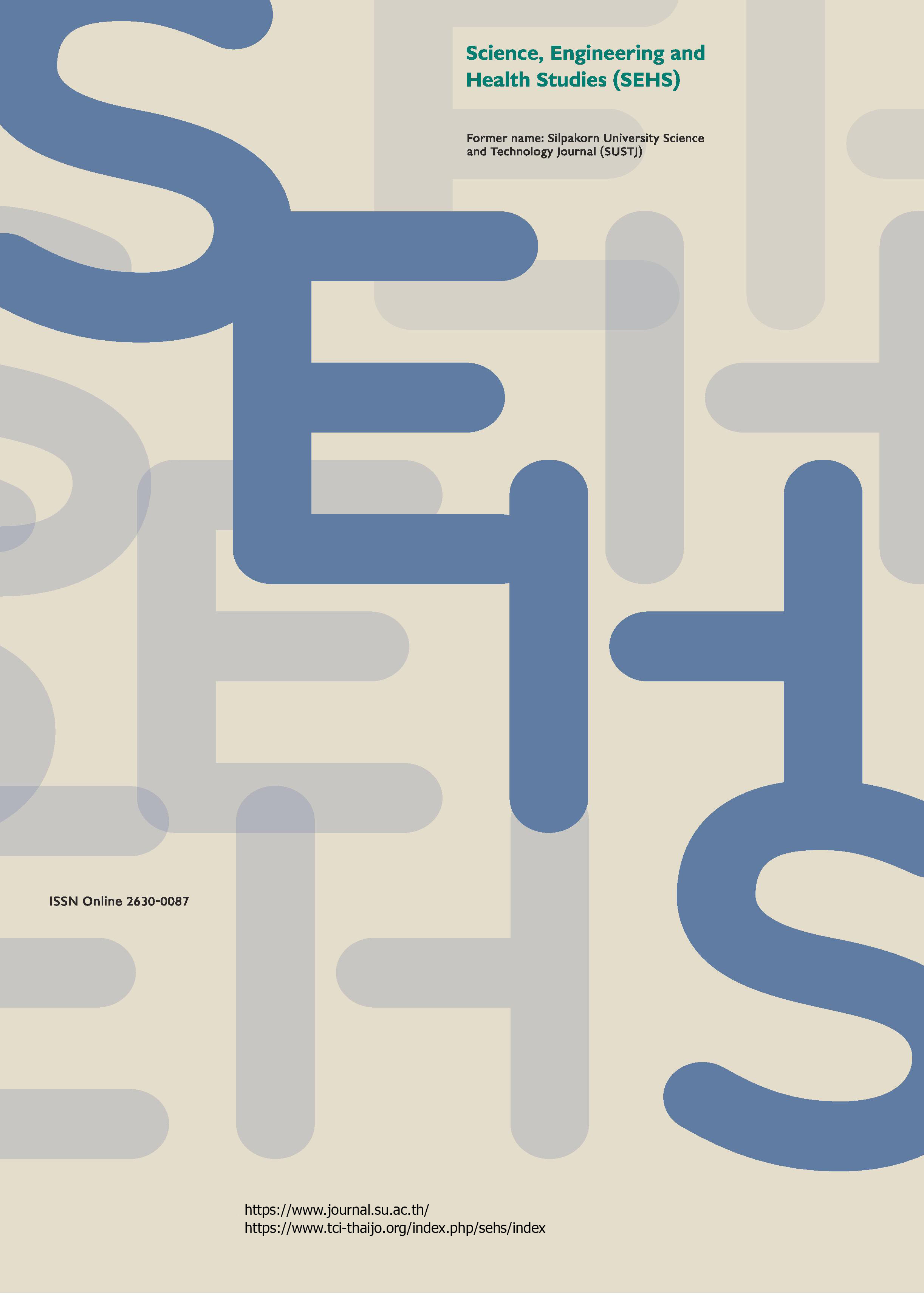Reforming time measurement of hydrophobic and hydrophilic insulator surface via centroid tracking
Main Article Content
Abstract
Flashover between insulator surfaces is the most serious issue impacting power system stability related to power failures. It is caused by insulator surface degradation, which causes a flashover loss in insulation efficiency due to a change in the hydrophobicity class (HC) described in IEC TS 62073. The surface tension method is one of the measurement techniques used in this study. This study aimed to research an algorithm for transitioning from conventional measurement methods to a suggested approach for classifying surface tension based on the reforming time that applies to the centroid tracking technique. This research provides manual input for the automated image processing method. The main method is centroid tracking segmentation in a wet area (CTSWA). The comparative timing between adjacent manual frames was examined, yielding results known as ground truth (GT), and our approach (CTSWA) was demonstrated. Most results had a reforming time variance of less than 3% compared to GT. The use of the studied method yields three benefits, including automatic reforming time verification, which can produce acceptable results from more sensitive and reliable insulator inspections. It can also be applied to preventive maintenance planning (PM). Additionally, it reduces the limitations of human decision-making.
Downloads
Article Details

This work is licensed under a Creative Commons Attribution-NonCommercial-NoDerivatives 4.0 International License.
References
Alabid, N. (2021). Interpretation of spatial relationships by objects tracking in a complex streaming video. ECTI Transactions on Computer and Information Technology, 15(2), 245–257.
Arulmurugan, R., and Anadakumar, H. (2018). Region-based seed point cell segmentation and detection for biomedical image analysis. International Journal of Biomedical Engineering and Technology, 27(4), 273–289.
Ata, M. M., Ashour, A. S., Guo, Y., and Abd Elnaby, M. M. (2018). Centroid tracking and velocity measurement of white blood cell in video. Health Information Science and Systems, 6, 20.
Barnich, O., and Van Droogenbroeck, M. (2011). ViBe: A universal background subtraction algorithm for video sequences. IEEE Transactions on Image Processing, 20(6), 1709–1724.
Berg, M., Thottappillil, R., and Scuka, V. (2001). Hydrophobicity estimation of HV polymeric insulating materials development of a digital image processing method. IEEE Transactions on Dielectrics and Electrical Insulation, 8(6), 1098–1107.
Chen, X., Li, C., Huang, X., Zhao, L., and Song, W. (2005). On-line estimating the level of hydrophobicity of composite insulators using the digital images. In Proceedings Electrical Insulation Conference and Electrical Manufacturing Expo, pp. 216–221. Indianapolis, India.
Cucchiara, R., Grana, C., Piccardi, M., and Prati, A. (2003). Detecting moving objects, ghosts, and shadows in video streams. IEEE Transactions on Pattern Analysis and Machine Intelligence, 25(10), 1337–1342.
Hanumantharaju, M. C., Vishalakshi, G. R., Halvi, S., and Satish, S. B. (2012). A novel FPGA based reconfigurable architecture for image color space conversion. In Global Trends in Information Systems and Software Applications. ObCom 2011. Communications in Computer and Information Science, vol 270 (Krishna, P. V., Babu, M. R., and Ariwa, E., Eds.), pp. 292–301. Berlin, Heidelberg: Springer.
Hidayatullah, P., and Konik, H. (2011). CAMSHIFT improvement on multi-hue object and multi-object tracking. In Proceedings of the 2011 International Conference on Electrical Engineering and Informatics, pp. 1–6. Bandung, Indonesia.
IEC TS 62073. (2016). Guidance on the measurement of hydrophobicity of insulator surfaces. [Online URL: https://standards.globalspec.com/std/9991614/iec-ts-62073] accessed on May 17, 2021.
Jazayeri, A., Cai, H., Zheng, J. Y., and Tuceryan, M. (2011). Vehicle detection and tracking in car video based on motion model. IEEE Transactions on Intelligent Transportation Systems, 12(2), 583–595.
Meenatchi, K., and Subhashini, P. (2014). Multiple object tracking and segmentation in video sequences. International Journal of Advance Research in Computer Science and Management Studies, 2(5), 71–79.
Ramalla, I., Gupta, R. K., and Bansal, K. (2015). Effect on superhydrophobic surfaces on electrical porcelain insulator improved technique at polluted areas for longer life and reliability. International Journal of Engineering & Technology, 4(4), 509–519.
Rani, T. J., and Priyadharsini, S. S. (2010). Region of interest tracking in video sequences. International Journal of Computer Applications, 3(7), 32–36.
Sonkaeo, P., and Techawatcharapaikul, C. (2021a). Hydrophobicity class of porcelain insulators based on information image feature extraction via image processing. International Journal of Industrial Electronics and Electrical Engineering, 9(1), 12–15.
Sonkaeo, P., and Techawatcharapaikul, C. (2021b). The hydrophobicity class of porcelain insulator detection based on digital image processing: A paper review. In Proceedings of the 18th International Conference on Electrical Engineering/Electronics, Computer, Telecommunications and Information Technology. pp. 759–762. Chiang Mai, Thailand.
Trivedi, M. M., and Mills, J. K. (2020). Centroid calculation of the blastomere from 3D Z-Stack image data of a 2-cell mouse embryo. Biomedical Signal Processing and Control, 57(4), 101726.
Ulman, V., Maška, M., Magnusson, K. E. G., Ronneberger, O., Haubold, C., Harder, N., Matula, P., Matula, P., Svoboda, D., Radojevic, M., Smal, I., Rohr, K., Jaldén, J., Blau, H. M., Dzyubachyk, O., Lelieveldt, B., Xiao, P., Li, Y., Cho, Y., … Ortiz-de-Solorzano, C. (2017). An objective comparison of cell-tracking algorithms. Nature Methods, 14, 1141–1152.
Xing, F., and Yang, L. (2016). Robust nucleus/cell detection and segmentation in digital pathology and microscopy images: A comprehensive review. IEEE Reviews in Biomedical Engineering, 9, 234–263.
Xu, Z. (2013). A static contact angle algorithm for silicone rubber aging experiments. IEEE Transactions on Power Delivery, 28(1), 491–498.
Yilmaz, A., Javed, O., and Shah, M. (2006). Object tracking: A survey. ACM Computing Surveys, 38(4), 13.
Zhi, X., Meng, S., and Shen, H. (2018). High density cell tracking with accurate centroid detections and active area-based tracklet clustering. Neurocomputing, 295, 86–97.
Zhong, Q., Chen, Z., Zhang, X., and Hu, G., (2014). Feature-based object location of IC pins by using fast run length encoding BLOB analysis. IEEE Transactions on Components, Packaging and Manufacturing Technology, 4(11), 1887–1898.


